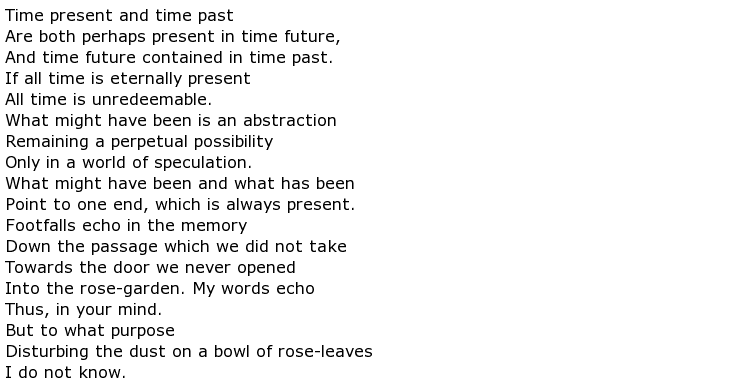

The Dry Salvages, meanwhile, are three rocks that provided sailors with a natural nautical marker off the eastern tip of Cape Ann in Massachusetts. Similarly, East Coker is the name of the quaint country village from which Eliot’s ancestor Andrew Eliot emigrated to the Massachusetts Bay colony in the mid-17th century. It is located in Gloucestershire, the Eliot family’s ancestral region in western England, but more significantly, it is a locale that he visited with an old love from his youth, Emily Hale, who frequently spent summers with her relatives and Eliot in England during the mid-1930s while Eliot was separated from his first wife, Vivien. Burnt Norton is an otherwise obscure English country house that burned to the ground in the 17th century. Little by little, particularly as each quartet is read and reread in combination with the incremental experience in mind as well of having read and reread the other three, any careful reader will gradually come to notice features either that all four of the quartets share or that are contrasted significantly with one to another.Įach of t he four quartets has for its title and as its primary subject matter an actual place that bears some degree of association with the poet. The Four Quartets’ individual quartets, in the order of their composition as well as their placement in the sequence, are “Burnt Norton,” “East Coker,” “The Dry Salvages,” and “Little Gidding.” Read as if they were conceived and composed as the consecutive and interactive elements in a preconceived sequence to begin with, they will not disappoint any reader.
.jpg)
A survey of the four individual poems that would eventually compose this mature poetic achievement of Eliot’s, furthermore, also exposes much about the manner in which Eliot conceived of the relationship among poetry writing, the poem, and the personal experiences that provide a framework for the former two. Such is the achievement of the poem in question, nonetheless, that the modernist literary canon would have had to have found a place for it even if Eliot had been a relative unknown at the time.

It was a singular publishing event, for t he Four Quartets came to be regarded almost from the first as one of the great literary masterpieces of a very rich literary century.īy then Eliot’s worldwide reputation as a poet was substantial enough to warrant such critical accolades, of course. A relatively slim volume of poetry, it nevertheless brought together between its covers a single, coherent poetic work that would prove to be the final fruits of a lifetime of creative endeavor on Eliot’s part as a poet. At the end of October 1943, in the midst of the terrible violence, destruction, and slaughter of World War II, Faber & Faber, Eliot’s publisher since the mid-1920s, released Four Quartets.


 0 kommentar(er)
0 kommentar(er)
